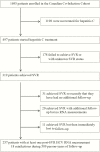Risk Factors for Hepatitis C Virus Reinfection After Sustained Virologic Response in Patients Coinfected With HIV
- PMID: 28199495
- PMCID: PMC5399935
- DOI: 10.1093/cid/cix126
Risk Factors for Hepatitis C Virus Reinfection After Sustained Virologic Response in Patients Coinfected With HIV
Abstract
Background: Highly effective hepatitis C virus (HCV) therapies have spurred a scale-up of treatment to populations at greater risk of reinfection after sustained virologic response (SVR). Reinfection may be higher in HIV-HCV coinfection, but prior studies have considered small selected populations. We assessed risk factors for reinfection after SVR in a representative cohort of Canadian coinfected patients in clinical care.
Methods: All patients achieving SVR after HCV treatment were followed with HCV RNA measurements every 6 months in a prospective cohort study. We used Bayesian Cox regression to estimate reinfection rates according to patient reported injection drug use (IDU) and sexual activity among men who have sex with men (MSM).
Results: Of 497 patients treated for HCV, 257 achieved SVR and had at least 1 subsequent RNA measurement. During 589 person-years of follow-up (PYFU) after SVR, 18 (7%) became HCV RNA positive. The adjusted reinfection rate (per 1000 PYFU) in the first year after SVR was highest in those who reported high-frequency IDU (58; 95% credible interval [CrI], 18-134) followed by MSM reporting high-risk sexual activity (26; 95% CrI, 6-66) and low-frequency IDU (22; 95% CrI, 4-68). The rate in low-risk MSM (16; 95% CrI, 4-38) was similar to that in reference patients (10; 95% CrI, 4-20). Reinfection rates did not diminish with time.
Conclusions: HCV reinfection rates varied according to risk. Measures are needed to reduce risk behaviors and increase monitoring in high-risk IDU and MSM if HCV elimination targets are to be realized.
Keywords: HIV; hepatitis C virus; reinfection; sustained virologic response; hepatitis C treatment.
© The Author 2017. Published by Oxford University Press for the Infectious Diseases Society of America.
Figures


References
-
- Peters L, Klein MB. Epidemiology of hepatitis C virus in HIV-infected patients. Curr Opin HIV AIDS 2015; 10:297–302. - PubMed
-
- Swain MG, Lai MY, Shiffman ML, et al. A sustained virologic response is durable in patients with chronic hepatitis C treated with peginterferon alfa-2a and ribavirin. Gastroenterology 2010; 139:1593–601. - PubMed
MeSH terms
LinkOut - more resources
Full Text Sources
Other Literature Sources
Medical

